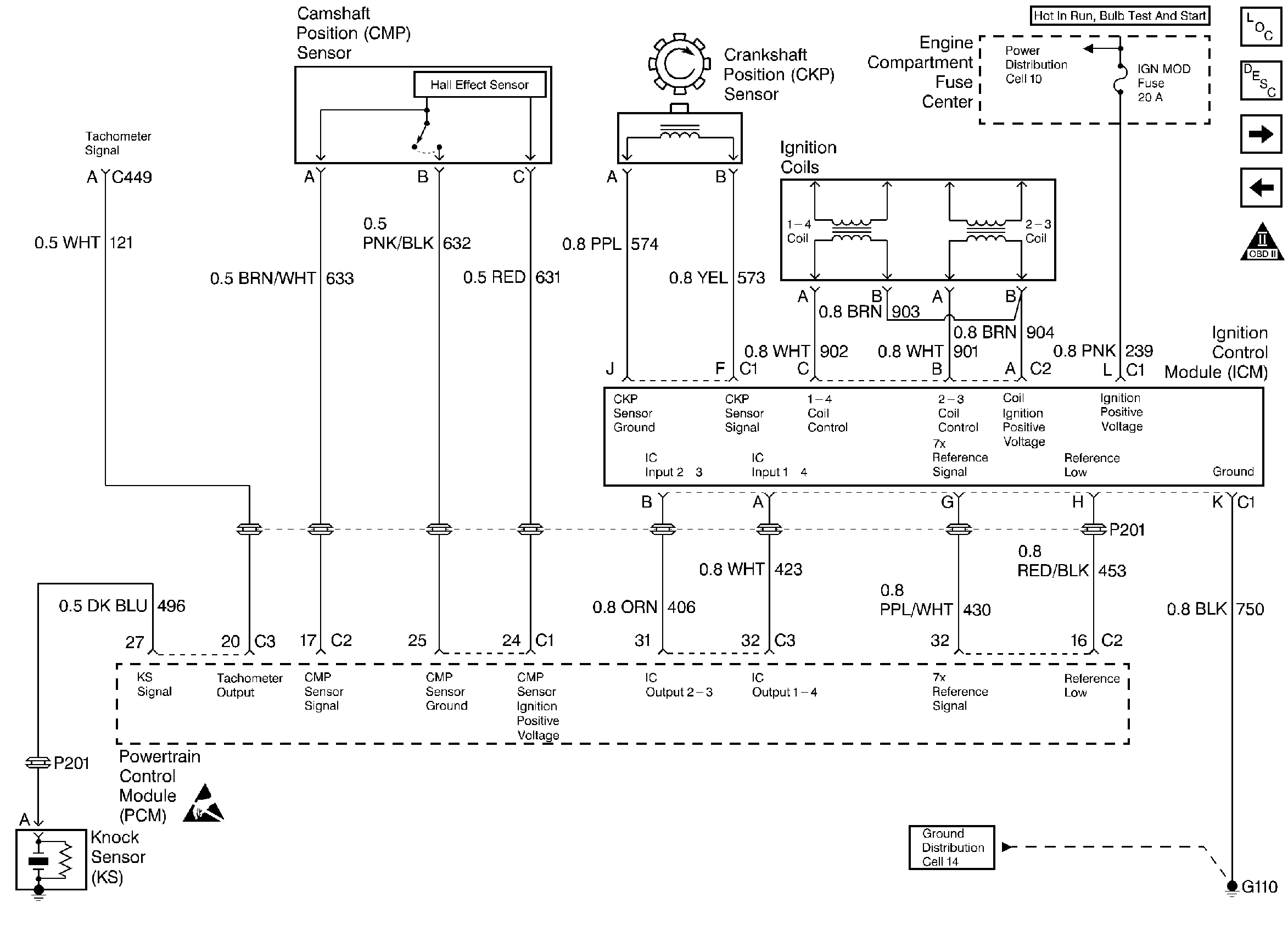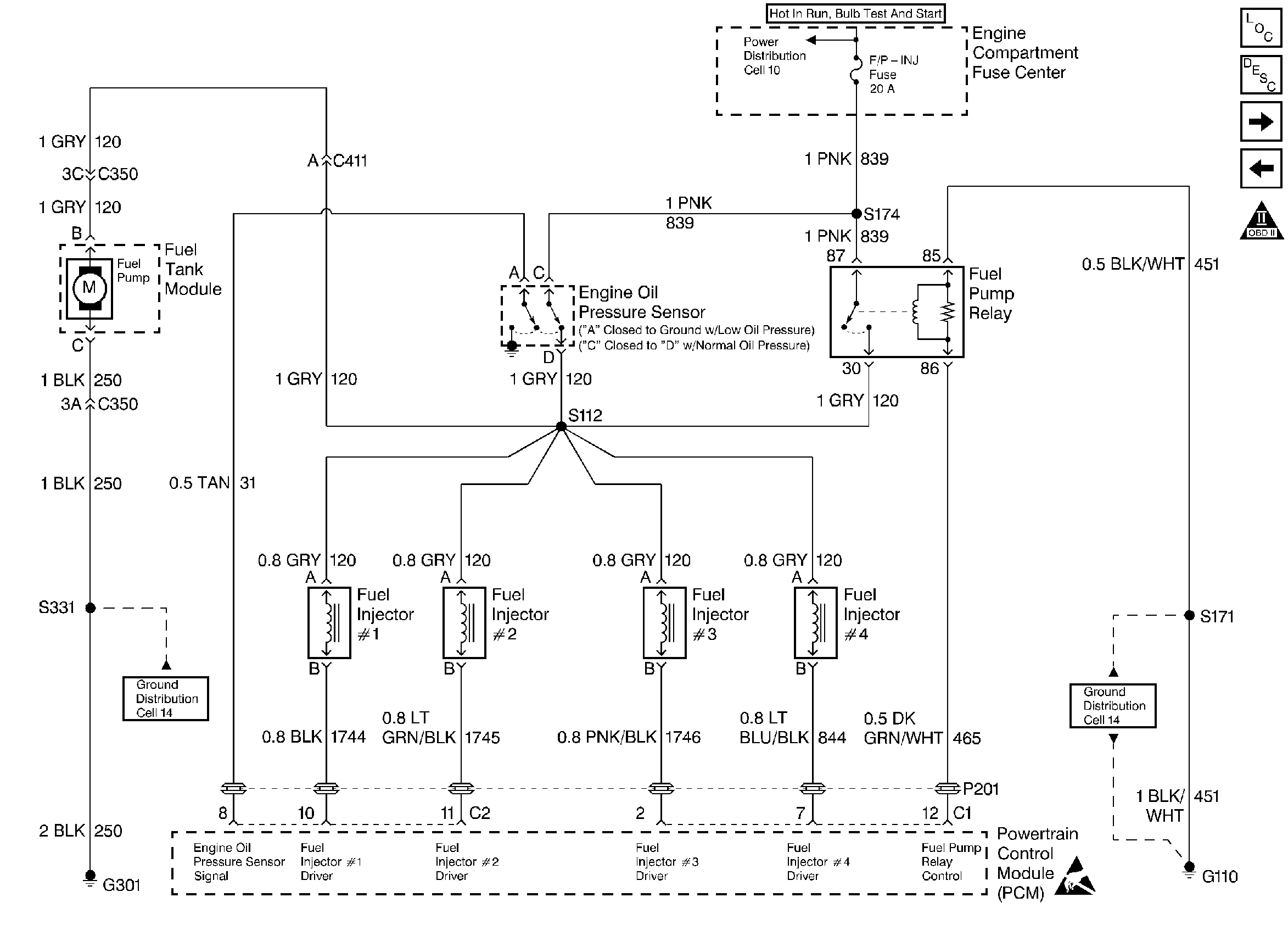Refer to
Ignition Controls

and
Fuel Controls

for
wiring view.
System Description
The Powertrain Control Module (PCM) monitors both the crankshaft and the camshaft position in order to detect an engine misfire. A rapid decrease in the crankshaft speed indicates misfire. The PCM may require that several consecutive misfire conditions are detected before storing this DTC and before illuminating the MIL. Under light misfire conditions, the PCM may require more than one trip to set this DTC. Under a severe misfire, the PCM flashes the MIL. A flashing MIL indicates that there is a misfire that is capable of damaging the catalytic converter. The torque converter clutch (TCC) disables momentarily in order to determine if the misfire was due to a rough road condition, automatic transmission only.
Conditions for Setting the DTC
| • | Misfire total is greater than 12 counts. |
| • | Engine speed is between 469 RPM (automatic trans.) or 750 RPM (manual trans.) and 3400 RPM |
| • | Battery voltage is between 9 volts and 17 volts. |
| • | Engine Coolant Temperature (ECT) is between -7° C (20° F) and 123° C (254° F). |
| • | Engine has been running more than 15 seconds. |
| • | Throttle Position (TP) hasn't changed more than 8 % in 1 second. |
| • | DTC(s) P0106, P0107, P0112, P0113, P0117, P0118, P0121, P0122, P0123, P0125, P0131, P0132, P0133, P0134, P0171, P0172, P0325, P0335, P0341, P0342, P0401, P0502, P0503, P0601, P0742, P1133, and P1406 not set. |
Action Taken When the DTC Sets
| • | The malfunction indicator lamp (MIL) illuminates if the fault is active within the same conditions for two out of eighty ignition cycles and a misfire is present. |
| OR |
| The MIL illuminates after two consecutive ignition cycles during in which the diagnostic runs with the fault active |
| OR |
| The MIL illuminates immediately and flashes if a misfire is severe enough to cause any catalyst damage. |
| • | In vehicles with automatic transmission only, the torque converter clutch (TCC) is disablesd when a misfire is present. |
| • | The PCM records the operating conditions at the time that the diagnostic fails. This information will store in the Freeze Frame and Failure Records buffers. |
| • | A history DTC is stored. |
| • | The coolant fan turns ON. |
Conditions for Clearing the MIL/DTC
| • | The MIL turns OFF after three consecutive ignition cycles during which the diagnostic runs without a fault present under the Freeze Frame conditions that existed when the DTC failed. |
| • | A history DTC clears after 40 consecutive warm up cycles without a fault. |
| • | Clear the MIL/DTCs with a scan tool. |
Diagnostic Aids
An intermittent can also be the result of a defective reluctor wheel. Remove crankshaft sensor and inspect reluctor wheel through sensor mount hole. Check for porosity and condition of wheel. Refer to DTC P0300 Engine Misfire Detected .
Verify the electronic Ignition Control Module (ICM) 11 pin harness connector terminal K, ground circuit should have less than 0.5 ohms of resistance.
If DTC is intermittent, refer to Symptoms .
When checking the electrical terminal connections with a test light or DMM, a malfunctioning electrical terminal connection maybe cleaned and not detected as a problem. You may also clean a corroded or dirty electrical terminal connection when disconnecting and reconnecting any electrical connector.
Test Description
Number(s) below refer to the step number(s) on the Diagnostic Table.
-
The Powertrain OBD System Check prompts the technician to complete some basic checks and store the freeze frame and failure records data on the scan tool if applicable. This creates an electronic copy of the data taken when the fault occurred. The information is then stored on the scan tool for later reference.
-
If a DTC P0200 is present, the condition causing misfire is in the injector circuitry. The DTC P0200 table will diagnose the injectors and circuitry.
-
A visual/physical inspection should include checking:
-
This step determines if DTC P0301 is the result of a hard failure or an intermittent condition.
-
If a plug boot is burned, the other plug on that ignition coil may still fire at idle. This step tests the system's ability to produce at least 25,000 volts at each spark plug.
-
If the misfire is not present it may be necessary to duplicate the conditions in the Freeze Frame Data in order to detect misfire. Depending on the engine load, the conditions may have to be maintained for up to 20 seconds. If the misfire accumulators starts to increment, then misfire is present. A history misfire counter will store the number of misfires that have occurred until the DTC is cleared. The current counter must count a total of at least 195 misfires before writing to the history counter.
-
Spark is available at the misfiring cylinder. At this point the misfire is being caused by a spark plug or a basic engine problem.
-
A basic engine problem that affects only cylinder #1 is possible at this point (i.e. valve train, compression, etc.). Refer to Section 6A .
-
Replace any spark plugs that are worn, cracked or fouled. Refer to Section 6A if any plugs are fouled or damaged due to an engine mechanical failure.
-
No spark, on one coil, may be caused by an open secondary circuit. Therefore, the coil's secondary resistance should be checked. Resistance readings above 20,000 ohms, but not infinite, will probably not cause a no start but may cause an engine miss under certain conditions.
-
If the no spark condition is caused by coil connections, a coil or a secondary boot assembly, the test light will blink.
-
The ignition coil harness can easily be checked by performing the previous step with the ignition coil harness connected to the ICM. Check for a voltage and ground signal to the ignition coils at the ignition coil electrical connector.
-
Refer to Ignition Coils for on vehicle service of the ignition system.
-
Refer to Ignition Coils for on vehicle service of the ignition system.
-
Refer to Ignition Control Module Replacement for on vehicle service of the ignition system.
-
Any circuitry, that is suspected as causing the complaint, should be thoroughly checked for backed out terminals, improper mating, broken locks, improperly formed or damaged terminals, poor terminal to wiring connections or physical damage to the wiring harness.
-
Conditions for setting the DTC P0420 need to be run to determine if the catalyst has been damaged from the misfire.
| • | Wiring for proper connections, pinches and cuts. |
| • | PCM grounds for being clean and tight. |
| • | Vacuum hoses for splits, kinks and proper connections as shown on the Vehicle Emission Information label. Check thoroughly for any type of leak or restriction. |
| • | For air leaks at the intake manifold sealing surface. |
Step | Action | Value(s) | Yes | No |
|---|---|---|---|---|
Was the Powertrain On-Board Diagnostic (OBD) System Check performed? | -- | |||
Install a scan tool. Was a DTC P0200 set? | -- | |||
Were any repairs necessary? | -- | |||
Idle the engine. Is the Misfire Current #1 counter incrementing? | -- | |||
Does the spark tester spark? | -- | |||
Is the Misfire Current #1 counter incrementing? | -- | |||
Is the Misfire Current #1 counter incrementing? | -- | |||
Is the action complete? | -- | -- | ||
Replace the spark plug. Is the action complete? | -- | -- | ||
Is the resistance less than the specified value? | 10 K ohms | |||
Does the test light blink? | -- | |||
12 | Remove the ignition coil from the ignition coil housing and recheck the resistance between the secondary terminals of the ignition coil. Is the resistance less than the specified value? | 10 K ohms | ||
Repair the open or the shorted ignition coil harness, poor ignition coil connection or replace the ignition coil, ignition coil housing or boot assembly. Is the action complete? | -- | -- | ||
14 |
Were any repairs necessary? | -- | ||
Replace the ignition coil springs for cylinders #1 and #4 coil. Is the action complete? | -- | -- | ||
Replace cylinders #1 and #4 ignition coil. Is the action complete? | -- | -- | ||
17 |
Are the resistance readings within the specified value? | 0.6 K-2.6 K ohms | ||
18 | Check the ignition control circuit for an open or a short and repair as necessary. Was a repair necessary? | -- | ||
Replace the ICM. Is the action complete? | -- | -- | ||
Inspect the PCM connector and connections and repair as necessary. Was a repair necessary? | -- | |||
21 | Replace the PCM. Is the action complete? | -- | -- | |
Does the scan tool indicate that these diagnostics have ran and passed? | -- | |||
23 | Check if any additional DTC's are set. Are any DTC's displayed that have not been diagnosed? | -- | Go to applicable DTC table | System OK |
